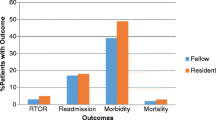Abstract
Operations on the liver and pancreas have fallen within the domain of the general surgeon and have been part of general surgery training. The more complex procedures involving these organs are limited in number in most general surgery residencies and do not afford an opportunity for vast experience. Moreover, fellowship programs in hepato-bilio-pancreatic (HPB) surgery and the development of laparoscopic techniques may have further limited the familiarity of general surgery residents with these operations. To determine the experience accrued by finishing general surgery residents, we accessed, through the Residency Review Committee of the Accreditation Council for Graduate Medical Education, the Resident Case Log System used by general surgery residents throughout their training to document operative cases. The number of operations on the gallbladder, bile ducts, pancreas, and liver was examined over the past 16 years (there were missing data for 3 years). Reference years 1995 and 2005 were compared to detect trends. Experience with laparoscopic cholecystectomy has steadily increased and averaged more than 100 cases in 2006. Experience in liver resection, distal pancreatectomy, and partial (Whipple) pancreatectomy has statistically improved from 1995 to 2005, but the numbers of cases are low, generally less than five per finishing resident. Experience in open common bile duct and choledocho-enteric anastomoses has statistically declined from 1995 to 2005, averaging less than four cases per finishing resident. The mode (most frequently performed number) for liver and pancreas resections was either 0 or 1. It is doubtful this experience in HPB surgery engenders confidence in many finishing residents. Attention should be focused on augmenting training in HPB surgery for general surgery residents perhaps through a combination of programmatic initiatives, ex vivo experiences, and minifellowships. Institutional initiatives might consist of defined HPB services with appropriate expertise, infrastructure, process, and outcome measures in which a resident-oriented, competency-based curriculum could be developed.




Similar content being viewed by others
References
Ong E, Helton WS, Espat NJ. HPB other 168: operative experience of U.S. general surgery residents: liver and pancreas 1989–2001. J Gastrointest Surg. 2003;7:311.
Cheadle WG, Franklin GA, Richardson JD, Polk HC Jr. Broad-based general surgery training is a model of continued utility for the future. Ann Surg. 2004;239:627–636.
Livingston EH, Rege RV. Technical complications are rising as common bile duct exploration is becoming rare. J Am Coll Surg. 2005;201:426–433.
Dixon E, Vollmer CM, Bathe O, Sutherland F. Training, practice, and referral patterns in hepatobiliary and pancreatic surgery: survey of general surgeons. J Gastrointest Surg. 2005;9:109–114.
Fong Y, Gonen M, Rubin D, Radzyner M, Brennan MF. Long-term survival is superior after resection for cancer in high-volume centers. Ann Surg. 2005;242:540–547.
Ko CY, Maggard M, Agustin M. Quality in surgery: current issues for the future. World J Surg. 2005;29:1204–1209.
Debas HT, Bass BL, Brennan MF, et al. American Surgical Association blue ribbon committee report on surgical education: 2004. Ann Surg. 2005;241:1–8.
Ihse I, Haglund U. The Swedish 40-hour work week: how does it affect surgical care? Surgery. 2003;134:17–18.
Granger SR, Glasgow RE, Battaglia J, et al. Development of a dedicated hepatopancreaticobiliary program in a university hospital system. J Gastrointest Surg. 2005;9:891–895.
Tseng JF, Pisters PWT, Lee JE, Wang H, Gomez HF, Sun CC, Evans DB. The learning curve in pancreatic surgery. Surgery. 2007;141:456–463.
Anastakis DJ, Regehr G, Reznick RK, Cusimano M, Murnaghan J, Brown M, Hutchison C. Assessment of technical skills transfer from the bench training model to the human model. Am J Surg. 1999;177:167–170.
Cundiff GW, Weidner AC, Visco AG. Effectiveness of laparoscopic cadaveric dissection in enhancing resident comprehension of pelvic anatomy. J Am Coll Surg. 2001;192:492–497.
Lord JL, Cottam DR, Dallal RM, Mattar SG, Watson AR, Glasscock JM, Ramanathan R, Eid GM, Shauer PR. The impact of laparoscopic bariatric workshops on the practice patterns of surgeons. Surg Endosc. 2006;20:929–933.
Leach DC. Competence is a habit. JAMA. 2002;287:243–244.
Author information
Authors and Affiliations
Corresponding author
Rights and permissions
About this article
Cite this article
Helling, T.S., Khandelwal, A. The Challenges of Resident Training in Complex Hepatic, Pancreatic, and Biliary Procedures. J Gastrointest Surg 12, 153–158 (2008). https://doi.org/10.1007/s11605-007-0378-6
Received:
Accepted:
Published:
Issue Date:
DOI: https://doi.org/10.1007/s11605-007-0378-6




